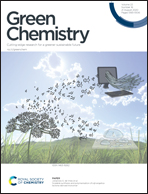Stability of ionic liquids in Brønsted-basic media
Abstract
Ionic liquids are generally recognized as highly stable compounds with high thermal decomposition temperatures and wide electrochemical windows. While the former claim has been the subject of recent scrutiny and controversy, comparatively little attention has been paid to another important aspect of ionic liquid applicability: their chemical stability. Brønsted bases constitute an important class of reagents to which ionic liquids are generally sensitive. Due to the positive charge of cations and the resultant polarization of methylene and methine protons in their structure, many ionic liquid cations tend to be weakly acidic and susceptible to either deprotonation or base-induced fragmentation. As a result, several common classes of ionic liquids are incompatible with Brønsted-basic reagents. This is unfortunate due to the wide scope of possible applications of strong Brønsted bases, in fields such as synthesis, catalysis and separations. Nevertheless, several authors have investigated the design of ionic liquids with improved resistance to Brønsted-basic reagents, and numerous reports exist on the stability of the common classes of cations in basic media. This review discusses the existing literature on the alkaline decomposition of ionic liquids.



 Please wait while we load your content...
Please wait while we load your content...